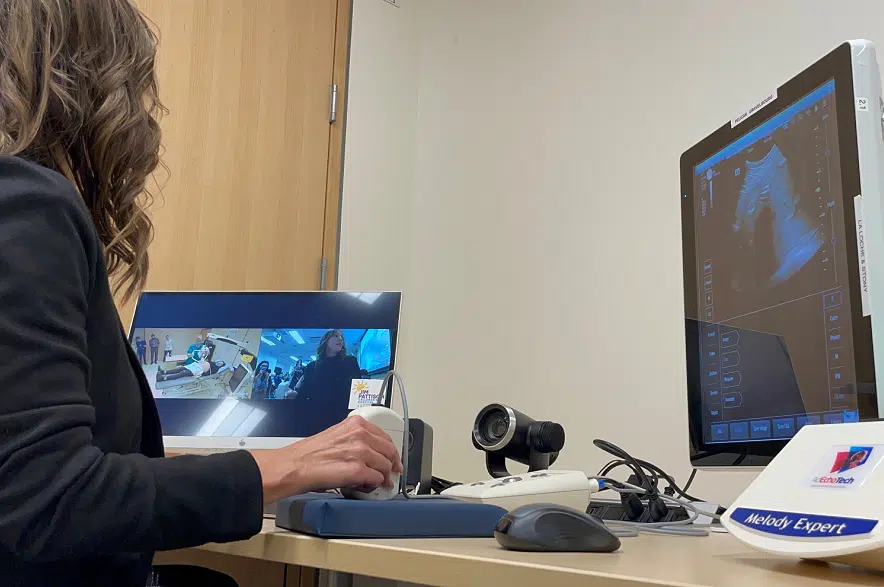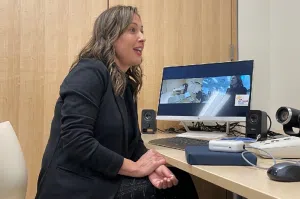At four locations around Saskatchewan, families can experience ultrasounds in their home communities while the hand controlling the probe is sometimes hundreds of kilometres away.
The new telerobotic system has recently been implemented in Gravelbourg, while the system is already up and running in more remote parts of the province like Pelican Narrows and Stony Rapids.
Dr. Ivar Mendez, professor of surgery and director of the virtual care and remote presence robotics program, said the program is the first and only one of its kind in Canada.
The program addresses the question of how to provide essential services to remote areas during a time where Saskatchewan’s health care system is struggling with staff shortages.
When it comes to pregnant women, who are vulnerable and require good prenatal care to have good outcomes, it can be tricky to ensure access to care when ultrasound systems and experts — called sonographers — aren’t present in all communities across the province.
Expectant mothers in small towns throughout the province know this difficulty well.
Cheri Rotheisler, a mother of four who has lived in small Saskatchewan towns her whole life, has lived in Gravelbourg for the past 25 years. During each pregnancy, she said she drove for more than an hour to Moose Jaw for her prenatal care appointments.
Until now, Moose Jaw has been the closest option for an ultrasound.
With most of her children born in the winter, Rotheisler said she’s regularly dealt with bad roads and poor visibility while trying to get to her appointments.
Having the virtual ultrasound option in her own community means she and other expectant women won’t have to take the risk of getting on the road — as well as making travel, childcare and work accommodations — just to get to their essential appointments.
Rotheisler said the virtual ultrasounds will also take pressure off centres like Moose Jaw, which see extra demand for ultrasound appointments from outlying communities.
“An individual can actually move a probe in Saskatoon, and the probe will actually move 600 kilometres away in another community, in real time,” Mendez explained.
The diagnostic procedure is done using a remote probe similar to the probe that would be in a sonographer’s hand if they were performing the ultrasounds in person.
The sonographer, Mendez explained, can view ultrasound images on one screen while seeing the patient and the telerobotic machine on another, just like a video chat. The sonographer is also able to speak to the patient and instruct a health-care worker in the room on where to move the machine as they control the probe on a mother-to-be’s abdomen.
Mendez said telerobotic systems could also lead to significant advancements in areas like acute care, where doctors could use remote ultrasound and eventually other telerobotic technology to treat trauma patients or to perform more routine tasks like inserting IVs.
The system needs only a regular Internet connection, just like the ones many people use at home. All the data transmitted is encrypted, Mendez said, and complies with the requirements for transmission of confidential medical data.
So far, Mendez said, 300 ultrasounds have been performed using the system in remote communities.
“A mother doesn’t have to travel eight hours to Saskatoon (and) be in a hotel waiting for their ultrasound,” Mendez explained.
Mendez said Saskatchewan’s shortage of health-care workers is becoming more acute, and includes specialized technicians like sonographers. The telerobotic program, he added, helps address the issues.
“You can imagine one individual that has the expertise being able to serve 10 communities,” Mendez shared.
Sonographer Natalie Kanigan, who has been with the robotics program for several years, said patients are very appreciative of the new innovation.
“People are just so thankful that they have access to the technology, that we’re bringing it to them,” Kanigan said.
She said the virtual ultrasound procedure isn’t much different from what she would do with a patient in the same room, apart from the limitation of having to instruct someone to move around the machine.
The new technology has required some troubleshooting, but Kanigan said that’s par for the course considering the large-scale implementation required.
While the technology can never completely replace the human touch of a doctor or nurse, Mendez said there are a number of steps that could be taken to expand access to the program and allow health-care professionals more time to focus on patient care.
“We have a shortage of health-care workers. Our emergency rooms are full and busy. Our hospitals are packed, so we need technology to allow us to reach these challenges that we are confronted with,” Mendez said.
“They will be tools that will allow us to be more efficient in terms of the delivery of care.”












